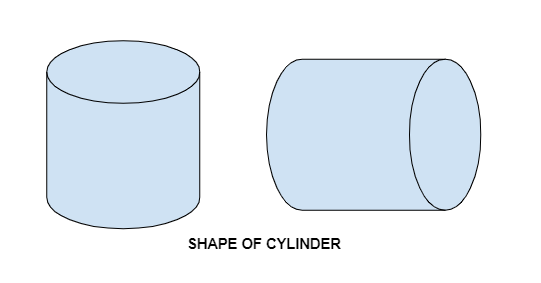Table of Contents
Definition of a Cylinder
A cylinder shape is a three-dimensional that looks like a tube or a can of soda. It has two flat circular bases that are parallel to each other. The bases are connected by a curved surface, which wraps around the sides of the cylinder.

The important thing about the curved surface is that it is always the same distance from the center of the cylinder.
Real-life Examples of Cylinders
Cylinders can be found in many things we see around us every day. One common example is a can of soda or a water bottle. These containers have a cylinder shape. Another example is an LPG gas cylinder used in our homes for cooking. If you look at the shape of a pencil, you’ll notice that it’s also cylindrical.
Cylinders are used in many other things as well. Fire extinguishers, some types of batteries, and even some buildings have cylindrical shapes. So, the next time you see a can of soda or a water bottle, remember that you’re looking at a real-life example of a cylinder!
Properties of Cylinders
Each shape possesses unique properties that distinguish it from others, and cylinders are no exception. Let’s explore some of the key characteristics of cylinders:
- Curved Surface and Identical Flat Faces: A cylinder has one curved surface that wraps around its sides, along with two flat faces that are identical and parallel to each other.
- Congruent Circular Bases: The two circular bases of a cylinder are congruent to each other, meaning they have the same size and shape.
- Size Determined by Radius and Height: The size of a cylinder is determined by the radius of its circular base and the height of its curved surface.
- Absence of Vertex: Unlike shapes like cones, cubes, or cuboids, a cylinder does not have any vertex or specific corner point.
- Identical Bases: The top and bottom of a cylinder are identical, meaning it has the same base shape throughout its entire structure. The base can be either circular or elliptical.
Types of Cylinder
Right Cylinder
When the cylinder’s axis forms a right angle with the bases, with one base directly above the other, it is known as a “Right Cylinder.”
Oblique Cylinder
If the bases of a cylinder are not directly above each other but positioned sideways, and the axis does not form a right angle with the bases, it is referred to as an “Oblique Cylinder.”
Right Circular Cylinder
A cylinder with circular bases is called a “Right Circular Cylinder.” This is the most common type of cylinder encountered in everyday life.
Elliptical Cylinder
In some cases, the bases of a cylinder may take the shape of an ellipse. Such a cylinder is known as an “Elliptical Cylinder.”
Surface Area and Volume
Cylinders have two important properties that help us understand their shape and size: surface area and volume of the cylinder. These properties provide us with valuable information when working with cylinders in geometry and real-life applications.
Explanation of Surface Area
- Curved Surface Area
The curved surface area of a cylinder refers to the outer surface that wraps around its sides. Imagine peeling off the labels from a can of soda. The resulting cylinder shape would be the curved surface of the cylinder. To calculate the curved surface area, we need to find the height (h) of the cylinder and the radius (r) of the circular base. The formula for the curved surface area is:
Curved Surface Area = 2πrh
Here, π (pi) represents a mathematical constant approximately equal to 3.14159.
- Area of Circular Bases
The cylinder has two circular bases—one at the top and one at the bottom. To find the area of each circular base, we use the formula for the area of a circle:
Area of a Circle = πr2
The radius (r) of the circular base is crucial in calculating the base’s area. Since there are two circular bases, we multiply the area by 2 to account for both bases.
- Total Surface Area Formula
To obtain the total surface area of a cylinder, we add the curved surface area to the sum of the areas of the two circular bases. The formula for the total surface area is:
Total Surface Area = 2πrh + 2πr2
Explanation of Volume
Volume measures the amount of space occupied by a cylinder. Think of it as the amount of water a container can hold. In the case of a cylinder, the volume tells us how much it can store. The formula for the volume of a cylinder is:
Volume = πr2h
The radius (r) and height (h) of the cylinder are essential in determining its volume. By multiplying the area of the circular base (πr2) by the height (h), we can find the volume of the cylinder.
Frequently Asked Questions on Cylinders
What is a cylinder?
A cylinder is a three-dimensional shape that consists of two parallel circular bases connected by a curved surface, with the same distance from the center throughout.
What are the properties of a cylinder?
The properties of a cylinder include congruent and parallel bases, the possibility of being a right or oblique cylinder, uniform cross-section, and the option of having circular or elliptical bases.
How do you find the surface area of a cylinder?
The surface area of a cylinder can be calculated by adding the curved surface area (2πrh) to the sum of the areas of the circular bases (2πr^2).
How do you find the volume of a cylinder?
The volume of a cylinder can be found by using the formula πr^2h, where r is the radius of the circular base and h is the height of the cylinder.








